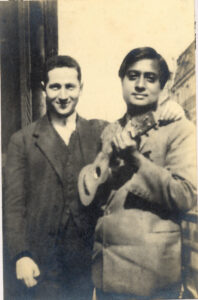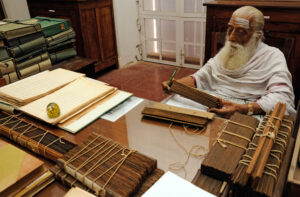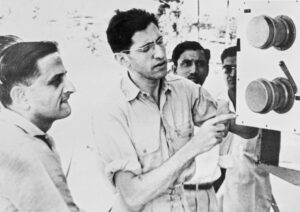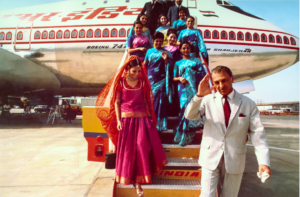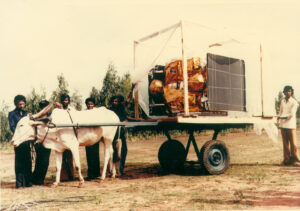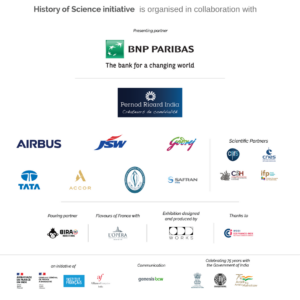Bertrand Zadoc-Kahn (left) with Satyendra Nath Bose in Paris (1924–25). Both were friends and Bertrand Zadoc-Kahn introduced Satyendra Nath Bose to many other French personalities.
Source: https://newweb.bose.res.in/Prof.S.N.Bose-Archive/
The Science Beyond Borders exhibition showcases the shared scientific history of Indo-French collaborations. Curated by Institut Français en Inde and its partners, the exhibition has been conceived specifically for this edition of Bonjour India marking 75 years of Independence and 75 years of the establishment of Indo-French relations. The Bonjour India festival has thus been conceived as a gift from France to India on this occasion. Dr. Samuel Berthet, the Director of Alliance Française of Hyderabad, a historian in his own right, is not only a major contributor to the exhibition but will also be one of the key speakers at the Inauguration of the Exhibition at Hyderabad.
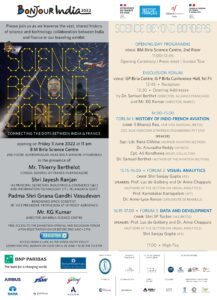 Science Beyond Borders: Inauguration Invite
Science Beyond Borders: Inauguration Invite
Inauguration: 3 June , 11 am onwards | BM Birla Science Centre, Near Birla Mandir, Adarshnagar, Hyderabad | Entry free ONLY against pre registration which will close at 2 pm on 2 June.
The Exhibition will be open to public from 4-26 June from 10.30am-8pm | Entry by venue policy | Schools are advised to get in touch with the gallery stating Science Beyond Borders to avail preferential rates.
Telling the story of this relationship was natural. Little known, but the scientific partnership is an important aspect of this shared history and mutual friendship. The History of Science initiative of the Institut Français in India takes you on a first journey into this extraordinary history and the stories of exchanges between the top minds of the two countries across centuries right until the modern-day.
Pandit S. Sambandasivacharya (1927–2019), joined the IFP in 1969 and worked on several Critical Editions of the Saiva Agamas for fifty years. He was a recipient of the Palmes Académiques award and the President’s Certificate of Honour for his scholarship and contributions to the field of Sanskrit studies. (Source: © IFP, 2015)
The history of science initiative is a beginning in bringing this rich past out of archives and institutions and research papers and personal memories. It is but the tip of the iceberg and a starting point to unravelling this story bit by bit, piece by piece, through narratives, texts, interviews, photographs, objects, audio-visual material and archival resources.
Indian Flight Cadets undergoing training on the MS 755 Fleuret, with French technicians, including one who is wearing a turban.
Image Courtesy: Ranjan Banerji / Late AVM M Banerji
As countries of science and civilization since times immemorial, our peoples have interacted, exchanged, travelled and collaborated for centuries and decades. The oldest traces of common history between France and the Indian subcontinent dates back to medieval history, especially in the field of knowledge. Thus, in order to bring this perspective, the story had to dive deep back into the ancient world, in the exchanges that transpired between European scientists and philosophers and the civilizations that emerged in Southern Asia. Some segments of the exhibition therefore also focus on ancient discoveries that shaped and caused the prolific scientific and technological achievements that happened in the 20th century and thereafter.
Yes, a meeting at the Fifth General Assembly of the Committee on Space Research (COSPAR) in Washington DC in 1962 connected Jacques Blamont, Founder of Scientific & Technical Director of the French Space Agency (CNES) and Vikram Sarabhai, father of the Indian space programme thereby paving the way for the Indian space programme on 21st November 1963 with the launch of a sodium vapour payload from Thumba brought to India by Jacques Blamont. This was followed by three more rocket-based experiences conducted by the French Centaurus, a two-stage solid propellant rocket provided by CNES to ISRO.
But that’s not all.
India’s First Rocket named ‘Nike-Apache’ (which means sounding rocket) was launched by Indian Space Research Organisation (ISRO) from Thumba Equatorial Rocket Launching Station (TERLS),Kerala on 21st November 1963. The rocket was so small that it could be carried by one hand, and hence was transported by a bicycle.
Image Courtesy: ISRO
The history of science and technology between the two countries is laden with precious gems pointing to invaluable, though little known, stories of ‘adventurers and pioneers’, comprising of scientists, academicians, entrepreneurs, institutions, engineers and government. The exhibition brings you stories across mathematics, medicine, nuclear science, biodiversity, aviation, physics, visual analytics, locomotives, astronomy, cartography and more.
The initiative will take you through some rare snippets of the prized Tata Central Archives, give you a peek into Airbus’ geospatial digital platform, bring to fore some brilliant records from the Institut Français de Pondichéry which is a repository of international research in cultures, environments and societies in South Asia, and delve into the experiences, memories, testimonies of many brilliant personalities, from India, from France.
This very popular picture represents APPLE in a testing phase before being shipped to the Guiana Space Centre for launch by Ariane 1. In the photo, we can see the satellite under a makeshift tent to protect it from dust and hitched to an oxcart.
India has chosen the European launcher Ariane every time its satellites were too heavy to be orbited by its own launchers. Since APPLE, some two dozen Indian satellites have been launched by an Ariane rocket.
Image Courtesy: ISRO
For regular updates of all our events and activities, follow us on:
![]() – @alliancefrancaise_hyderabad
– @alliancefrancaise_hyderabad
![]() – @alliance-française-hyderabad (Alliance Française of Hyderabad)
– @alliance-française-hyderabad (Alliance Française of Hyderabad)
![]() – @AFHyderabad (Alliance Française of Hyderabad)
– @AFHyderabad (Alliance Française of Hyderabad)
![]() – Alliance Française of Hyderabad
– Alliance Française of Hyderabad
More details at


